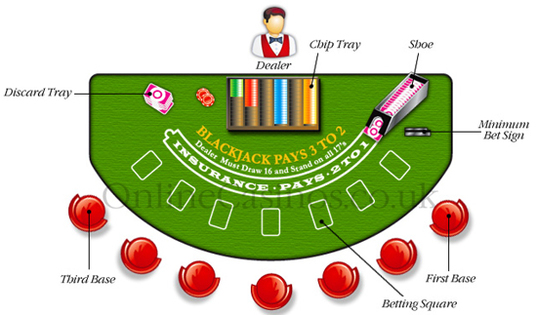What is Blackjack in a Nutshell?
Blackjack is the name given to the card game that requires players to aim for a hand of 21 or closest. There are many variants of blackjack today, all of them with similar rules. However, it is up to the player to ensure that he or she understands the particular rules of each variant before attempting to play. For the sake of uniformity, we will examine the rules of the game known as classic blackjack.
What is the Object of Blackjack?
Blackjack, played against the dealer, requires that the player reach a total of 21 with the cards dealt to him or her during the course of the game, without exceeding that number. Whoever manages to reach nearest to 21 without going ‘bust’ is declared the winner.
What are the Card Values in Blackjack?
- Royal cards (Kings, Queens and Jacks) have the value of 10.
- The Ace has the value either of 1 or 11.
- All other cards have their own face value.
- The suits of the cards are of no significance to the game.
What is the Blackjack Table?
A blackjack table is a customized table on which the game is played against the dealer. An average of six players can play at once around this table, although they do not influence one another and the cards they are dealt are of no consequence to the other players. At casinos, blackjack tables differ from one another according to the number of decks used and the minimum/maximum wagering requirements.

What is the Game Process in Blackjack?
- Players choose their blackjack tables according to the size of their bankroll and other personal criteria.
- Bets are placed on the table.
- The dealer deals two cards to himself and two to the player. One of the dealer’s cards is dealt face up. It should be noted that in some variants of blackjack, both cards are dealt face down.
- At this stage, players can make an insurance bet, which essentially means that they predict that the dealer has been dealt a blackjack. This bet pays out 2:1. Most players will risk taking an insurance bet if the dealer’s up card is an Ace, however it is important to remember that if the dealer does not have a blackjack, the player loses the bet.
- Once players have been dealt their initial two cards, they need to make a decision about how they will proceed in the game. When experts speak about the skill element in blackjack, this is the stage of the game where is helps the most.
What are the Playing Options Available at this Stage of Blackjack?
- Players can Stand: When players are dealt cards that are considered close enough to 21 without taking the risk of asking for another card, they can choose to ‘stand’. Essentially, this means that they will not request another card from the dealer and are expressing satisfaction with the cards dealt.
- Players can ask for a Hit: To request a hit from the dealer is another way of asking for another a card to be dealt. This option is usually taken when the player’s cards are usually low enough to risk adding another card value to the total. Of course, this option comes with the risk of the new card bringing the total over 21, which ultimately results in the player’s defeat in the game.
- Players can split their cards: In classic blackjack, if players are dealt two cards that are of equal denomination, they may – if they wish – split the cards into two separate hands. By placing a bet equal to their initial bet on the new hand, players are essentially playing two hands at once. There are various limitations on the number of times splitting can be done (if at all) according to the different variants played.
- Players can double down: What happens with a player who has been dealt an excellent hand and wants to make the most of it? In this case, a player can choose to double his original bet. However, this option comes with a price tag. In exchange, the player can only ask for one more card to be dealt.
- The player can surrender: In the same vein, a player who has been dealt unsatisfactory cards may want to leave the game and surrender his cards. The price tag on this move is that he forfeits half his initial bet; however this move is recommended if the player has more to lose by continuing with the game, than by staying put.
What is the Role of the Dealer in Blackjack?
The dealer is bound by the rules of the house and thus needs to act according to the blackjack variant being played. A player’s game strategy should take into account when a dealer is obliged to hit or stand as this can make a significant difference to his own success. In classic blackjack, it is generally accepted that a dealer needs to draw a new card (‘hit’) if his own cards don’t total more than 16, and ‘stand’ if his cards total 17 or more.
How does One Win in Blackjack?
- The player wins in blackjack if his hand beats the dealer’s.
- Alternatively, a deal of a pure blackjack – ie. a total of 21 from the first two cards – is considered an automatic win for the player. Payout is 1.5 times the original bet.
- A ‘push’ is when the dealer is also dealt a blackjack at the same time as the player is. In this case, the player is paid back his original bet.
- The player who manages to obtain a higher card count than the dealer’s is paid out an equal amount to his original bet.
- If the dealer goes bust (ie. exceeds 21), the player wins the bets, and vice versa.